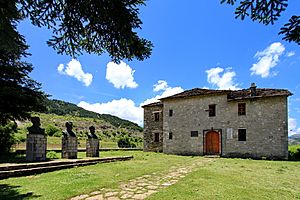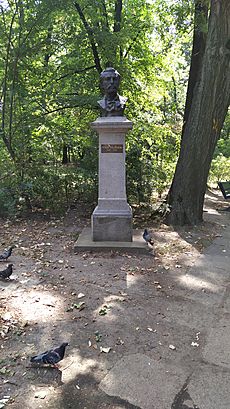Naim Frashëri facts for kids
Quick facts for kids
Naim Frashëri
|
|
|---|---|

Portrait of Naim Frashëri
|
|
| Born | 25 May 1846 Fraşer, Yanya Eyalet, Ottoman Empire (now Frashër, Albania) |
| Died | 20 October 1900 (aged 54) Kadıköy, Constantinople, Ottoman Empire (now Turkey) |
| Occupation |
|
| Language | |
| Alma mater | Zosimaia School |
| Genre | Romanticism |
| Literary movement | Albanian Renaissance |
| Relatives | Abdyl Frashëri (brother) Sami Frashëri (brother) Mid'hat Frashëri (nephew) Ali Sami Yen (nephew) |
| Signature | |
 |
|
Naim Frashëri (born May 25, 1846 – died October 20, 1900) was an important Albanian writer, poet, and translator. He is known as the national poet of Albania. Many people see him as a key figure in modern Albanian literature and one of the most influential Albanian cultural heroes of the 1800s.
Naim and his brothers, Abdyl and Sami, grew up in the village of Frashër. This village is located on the southern slopes of the Tomorr Mountains. Naim learned many languages and cultures, including Arabic, Ancient and Modern Greek, French, Italian, Ottoman Turkish, and Persian. He was one of the few people who knew both Western and Eastern literature very well.
After his father passed away, Naim and his family moved to Ioannina. Here, he found inspiration for his poems, which were written in a lyrical and romantic style. Later, he joined his brother Abdyl to help the Albanian people fight for their freedom and national identity. This period was called the Albanian Renaissance, and Naim became a leading figure in it.
Frashëri's best works explored ideas like freedom, kindness, unity, tolerance, and revolution. He wrote 22 works in total. Fifteen of these were in Albanian, four in Turkish, two in Greek, and one in Persian. His writings reached many people beyond Albania. He was a very important writer of sufi poetry in Albanian. Influenced by his uncle Dalip Frashëri, he tried to mix sufism with western philosophy in his poems. His work had a huge impact on Albanian literature and society in the 1900s, inspiring writers like Asdreni, Gjergj Fishta, and Lasgush Poradeci.
A famous line from his poem O malet e Shqipërisë is Ti Shqipëri, më jep nder, më jep emrin Shqipëtar (You, Albania, give me honor, and you name me as Albanian). This line is now the national motto of Albania. It talks about unity and freedom, showing great pride in the country and its people.
Contents
Life of Naim Frashëri
His Family and Early Life
Naim Frashëri was born on May 25, 1846. He came from a wealthy Albanian family in the village of Frashër. At that time, Frashër was part of the Ottoman Empire, but it is now in Albania. His family followed the Bektashi branch of Islam.
Naim, Abdyl, and Sami were three of eight children. Their parents were Halid Frashëri (1797–1859) and Emine (1814-1861). Halid was a landowner and a military leader. Emine's family came from the region around Korçë.
Naim's Education
Naim's religious background helped him a lot in his future achievements.
At the Tekke of Frashër, he studied many subjects. He learned languages like Arabic, Ottoman Turkish, and Persian. Since his family was Bektashi, he spent time in a Bektashi tekke (a special religious building).
After his parents died, the family moved to Ioannina in 1865. His oldest brother, Abdyl, became the head of the family. Naim and Sami went to the Zosimaia secondary school. This school gave Naim a good classical education, similar to Western schools. Besides the languages he learned there (Ancient and Modern Greek, French, and Italian), Naim also took private lessons in Persian, Turkish, and Arabic.
Naim finished his studies in 1870. He worked for a few months at a press office in Istanbul. But he had to return home because he suffered from tuberculosis. The climate in Frashër helped him get better. Soon, he started working for the Ottoman government as a clerk in Berat and then in Saranda (1872–1877). In 1876, he left his job and went to Baden, in modern Austria, to treat his rheumatism.
His Role in Politics
In 1879, Naim Frashëri, his brother Sami, and 25 other Albanians started the Society for the Publication of Albanian Writings in Istanbul. This group worked to publish books and other materials in the Albanian language. However, in 1885, the Ottoman authorities banned writing in Albanian. Because of this, many Albanian publications had to be printed outside the country. Naim used his initials, N.H.F., to hide his identity and publish his works. Later, Albanian schools were opened in southeastern Albania in 1887.
An Albanian magazine called Drita started in 1884. Petro Poga and later Pandeli Sotiri were its editors. Naim Frashëri secretly helped edit the magazine. He and other Albanian writers, like his brother Sami, used fake names in Poga's magazine. Since there weren't many school books, Naim, Sami, and others wrote textbooks in Albanian in the late 1880s. These books were for the Albanian school in Korçë.
Naim Frashëri died in Istanbul in 1900. In the 1950s, the Turkish government allowed his remains to be brought back to Albania and reburied there.
Naim Frashëri's Works
His Important Writings
"Oh mountains of Albania
and you, oh trees so lofty,
Broad plains with all your flowers,
day and night I contemplate you,
You highlands so exquisite,
and you streams and rivers sparkling,
Oh peaks and promontories,
and you slopes, cliffs, verdant forests,
Of the herds and flocks
I'll sing out which you hold
and which you nourish.
Oh you blessed, sacred places,
you inspire and delight me!
You, Albania, give me honour,
and you name me as Albanian,
And my heart you have replenished
both with ardour and desire.
Albania! Oh my mother!
Though in exile I am longing,
My heart has ne'er forgotten
all the love you've given to me ..."
from Bagëti e Bujqësi
Naim Frashëri played a huge role in developing the modern Albanian literary language. His writings were important not just for their style, but also for their social and political messages. He wanted to see an independent Albania where people were united, no matter their religion or where they lived. He believed strongly in progress and in the political, economic, and cultural growth of the Albanian people.
In his poem Bagëti e Bujqësi (Herds and Crops), Frashëri beautifully describes the natural and cultural beauty of Albania. He also writes about the simple life of its people, where everything seems peaceful and harmonious.
Frashëri believed his liberal religion could help Albania gain freedom and encourage tolerance among its people, who were divided by different faiths. Because of this, he wrote his religious work Fletore e Bektashinjet (The Bektashi Notebook). This book is now very important for the nation. It shares his beliefs and contains ten spiritual poems that show what the Bektashi sect believed at the time.
Here are some of his works:
- Kavâid-i farisiyye dar tarz-i nevîn (Grammar of the Persian language according to the new method), Istanbul, 1871.
- Ihtiraat ve kessfiyyat (Inventions and Discoveries), Istanbul, 1881.
- Fusuli erbea (Four Seasons), Istanbul, 1884.
- Tahayyülat (Dreams), Istanbul, 1884.
- Bagëti e Bujqësi (Herds and Crops), Bucharest, 1886.
- E këndimit çunavet (Reader for Boys), Bucharest, 1886.
- Istori e përgjithshme për mësonjëtoret të para (General history for the first grades), Bucharest, 1886.
- Vjersha për mësonjëtoret të para (Poetry for the first grades), Bucharest, 1886.
- Dituritë për mësonjëtoret të para (General knowledge for the first grades), Bucharest, 1886.
- O alithis pothos ton Skypetaron (The True Desire of Albanians), Bucharest, 1886.
- Luletë e Verësë (Flowers of the Summer), Bucharest, 1890.
- Mësime (Lessons), Bucharest, 1894.
- Parajsa dhe fjala fluturake (Paradise and the Flying Word), Bucharest, 1894.
- Gjithësia (Omneity), Bucharest, 1895.
- Fletore e bektashinjët (The Bektashi Notebook), Bucharest, 1895.
- O eros (Love), Istanbul, 1895.
- Iliadh' e Omirit, (Homer's Iliad), Bucharest , 1896.
- Histori e Skënderbeut (History of Skanderbeg), Bucharest, 1898.
- Qerbelaja (Qerbela), Bucharest, 1898.
- Istori e Shqipërisë (History of Albania), Sofia, 1899.
- Shqipëria (Albania), Sofia, 1902.
Naim Frashëri's Legacy
Naim Frashëri is seen as the most important Albanian poet of the Albanian Renaissance. His poetry greatly influenced Albanian literature and society in the 1900s. He is widely known as the national poet of Albania. People celebrate him in Kosovo, Montenegro, North Macedonia, and other areas where Albanians live in the Balkans.
After he died, Frashëri became a huge inspiration for Albanian writers and thinkers of the 20th century. These included Asdreni, Gjergj Fishta, Mitrush Kuteli, and Lasgush Poradeci. His major works like Bagëti e Bujqësi, Gjuha Jonë, and Feja encouraged national unity, awareness, and tolerance. They also sparked enthusiasm for the culture and history of their ancestors.
Albanians who followed the Bektashi faith were especially moved by his work. As a Bektashi himself, he wanted to keep the Albanian language pure. In his work Fletore e Bektashinjët, he tried to make the religious terms of the Bektashi order more Albanian. His poem Bagëti e Bujqësi praised Albania's natural beauty and the simple life of its people. It also showed his gratitude for Albania giving him "the name Albanian." In Istori' e Skënderbeut, he showed his love for Albania by writing about the medieval battles between Albanians and Ottomans. He highlighted Skenderbeg's Albanian roots and his successful fight for freedom. In Gjuha Jonë, he urged Albanians to honor their nation and write in Albanian. In another poem, Feja, he asked Albanians not to let religious differences divide them, as they all shared one origin and spoke Albanian.
Many organizations, monuments, schools, and streets are named after him in Albania, Kosovo, and to a lesser extent in North Macedonia and Romania. His family's house in Frashër, where he was born, is now a museum. It is considered an important cultural heritage site. The museum displays many items, including handwritten papers, portraits, clothes, and busts of him and his brothers, Abdyl and Sami.
Naim Frashëri's picture is on the front of the 500 lekë banknote from 1992 to 1996. Since 1996, he has been on the 200 lekë banknote. On the back of the 200 lekë bill, there is a picture of his family house in Frashër. The Albanian nation has also created an award named after him. This award has been given to important people, including the Albanian nun and missionary Mother Teresa.
Gallery
-
Frashëri on the obverse of 2017 200 Lekë polymer banknote
See also
 In Spanish: Naim Frashëri para niños
In Spanish: Naim Frashëri para niños
- List of Albanian writers
- Albanian Renaissance
- League of Prizren
Sources
- Frashëri, Alfred; Frashëri, Neki (2014). Frashëri në historinë e Shqipërisë. Dudaj. ISBN 978-99943-0-051-8.







